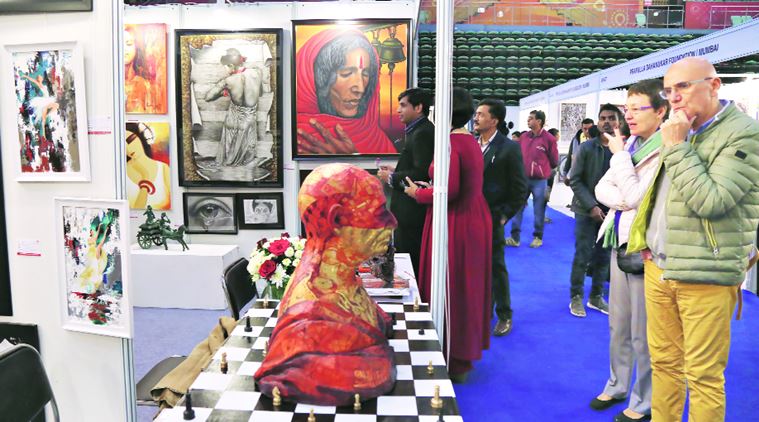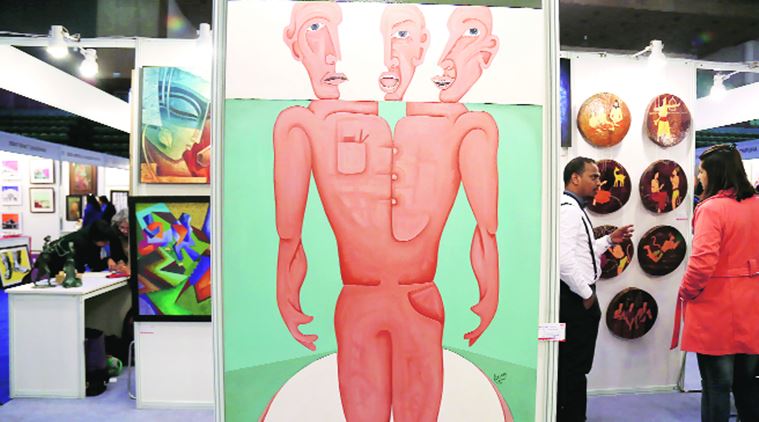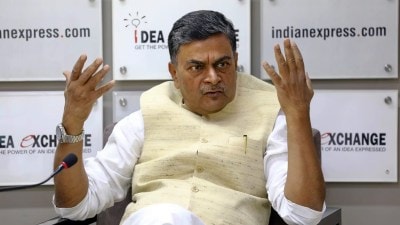India Art Festival: A low profile, affordable art festival in the Capital aims to give a platform to up-and-coming artists
The cost of putting up the show starts from Rs 60,000 per booth, an amount that could be shared between a group of artists.
 The exhibition area is of 3,000 square meters.
The exhibition area is of 3,000 square meters.
Before the more premier and talked about India Art Fair opens in Delhi, a more low key art event precedes it in the month of January. The India Art Festival, which is in its second edition, promotes itself as a more “affordable” outfit. “One of our primary objectives is to give a platform to artists who are not represented by galleries, and otherwise find it difficult to approach collectors. It is also a place where collectors can see the work of the masters at stalls put up by galleries as well as works of independent, young, and up-and-coming artists,” says Rajendra, founder and managing director of the fair. Also the vice president of the Bombay Art Society, he first launched the festival in Mumbai in 2011.
 The exhibition is showcasing works of over 375 artists and 35 galleries from across Asia, including participants from Dubai, Singapore and Tanzania.
The exhibition is showcasing works of over 375 artists and 35 galleries from across Asia, including participants from Dubai, Singapore and Tanzania.
When the festival opened on January 19 at Thyagaraj Stadium, unsurprisingly, it was not the high-heeled who dominated the crowd, but those who wanted to decorate their homes. There were also others who wanted to invest in the works of well-established artists but not necessarily in their most coveted works.
The exhibition area of 3,000 square meters has on display works of over 375 artists and 35 galleries from across Asia, including participants from Dubai, Singapore and Tanzania. The floor plan separates the galleries and independent artists, some of whom share booths. The cost of putting up the show starts from Rs 60,000 per booth, an amount that could be shared between a group of artists. “It is a very good opportunity for artists like me who are from smaller cities. Here, we can meet collectors as well as gallerists who might be interested in the work we do,” says Lucknow-based artist Vaishali Rastogi, who specialises in paper quilling. Selling her work across India through her Facebook page, at the festival the self-taught artist’s intricate technique is attracting attention. If a Ganesha, which she spent 480 hours making, is priced at Rs 50,800, a small jewellery box comes for Rs 1,000. Like her, Dharamsala-based Priyadarshini Ohol, too, hopes to network with gallerists at the festival. She has never participated in an exhibition but is confident her works will generate interest. “My work is good but I find it tedious to approach individual galleries. This is an ideal event to meet people,” she says.
 The event is at Thyagaraj Stadium.
The event is at Thyagaraj Stadium.
Tanzania-based Samina Sachak agrees. The encouraging response to a solo at Jehangir Art Gallery in Mumbai in November 2016, led her to consider participating in the festival, where she has canvases depicting creatures in the wild. Singapore-based P Gnana, artist and owner of Gnani Arts, with branches in Singapore and Chennai, is showing subjects that would interest Indian collectors, who, he says, appreciate works that have fragments borrowed from Indian culture.
While the festival does boast of masters such as KG Subramanyan, MF Husain, Jamini Roy and Thota Vaikuntam, their works are limited and most galleries have them with younger and lesser-known artists. The market might be slow, but gallerists feel that it is essential to maintain a connect with the buyers. “We want to show our entire range, so as to cater to people with varied tastes,” says Neetu Ambwani, co-director of Gallerie Art Eterne in Delhi. Having participated in the first edition of the festival as well, she specially commissioned artists to paint tables for the event. If one has a Prittam Priyalochan floral top, another has a Niren Sengupta abstract. The walls at her stall showcase Subramanyan and Jai Zharotia among others. Like her, Ronak Rudani of Mriya Arts also has his entire range on display, which includes Tanjore paintings apart from the masters and up and coming artists. Less than a year into the business, the collector-turned-gallerist says, “We are using this as a platform to introduce ourselves to the collectors. This is a portfolio we have built over decades,” says Udani.
 The exhibition in the Capital.
The exhibition in the Capital.
And though the mediums are varied, there are some artists attracting the audience due to sheer experimentation. If NIFT graduate Vinati Bhatt has serigraphs representing images associated with India, including its architectural monuments, Mumbai-based Wajid Khan uses nails to create a picture. Delhi-based Noor Arora has images etched on sandstone and slate surfaces. “It is an industrial technique but I wanted to bring it to fine art,” says Arora, 24. Featuring creatures from the animal world, the graduate in art history also has a message for the audience. “We need to sit up and take notice of the species that are getting extinct,” she says, even as a curious viewer questions her about the fine engravings.
The event is at Thyagaraj Stadium till January 22. Entry is free.



- 01
- 02
- 03
- 04
- 05
























